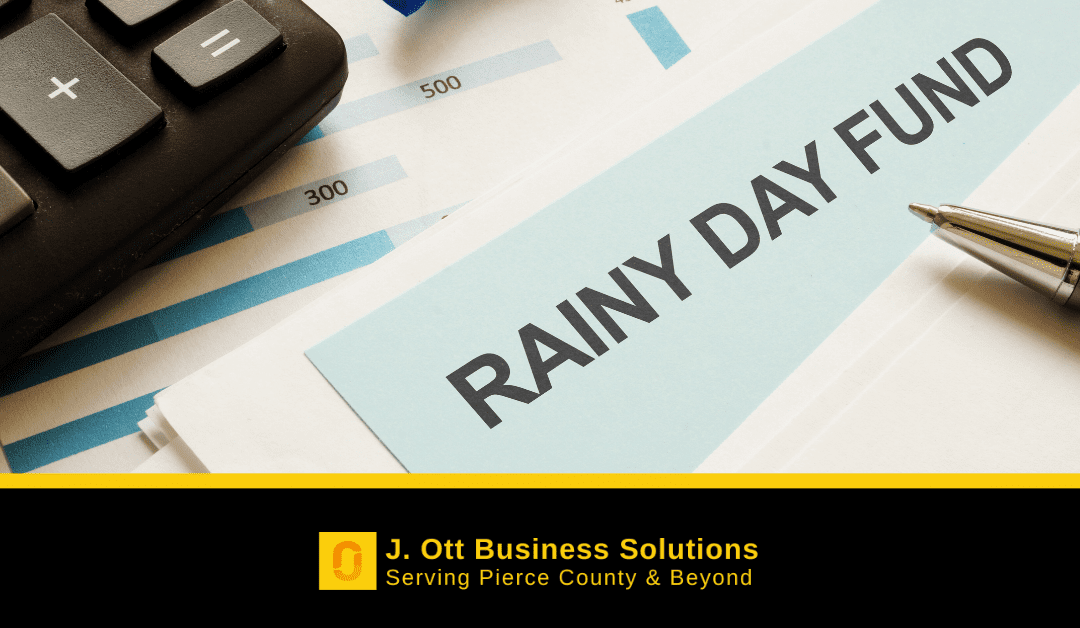What You’ll Learn in This Post
- Why every Tacoma business needs a cash reserve for unplanned expenses
- How to determine the right size rainy-day fund for your business
- Practical ways to build and maintain those reserves over time
- Common mistakes business owners make when preparing for emergencies
- How a trusted advisor can help you plan your financial safety net
Preparing for Unexpected Expenses:
Building a Rainy-Day Fund for Your Business
If you’ve lived or worked anywhere near the Puget Sound, you know the rain can show up when you least expect it. The same is true for running a small business. From sudden equipment breakdowns to surprise tax bills or a dip in sales, unexpected expenses can roll in like a storm, and without a financial umbrella, they can leave your business scrambling for cover.
For Tacoma and Pierce County business owners, an emergency fund isn’t just a safety measure; it’s a lifeline. Many small businesses operate on tight margins, meaning one unplanned cost can set back growth plans, delay payroll, or force tough decisions. Having a cash reserve in place protects your operations and gives you the confidence to make smart, proactive moves instead of reactive ones.
Why a Business Rainy-Day Fund Matters
Every business owner understands the value of cash flow, but not everyone plans for disruption. Market changes, equipment failures, or client payment delays can happen at any time—and all too often they happen all at once. A dedicated reserve helps you:
- Keep operations running without dipping into lines of credit
- Cover urgent expenses while maintaining vendor relationships
- Reduce stress when facing seasonal fluctuations or downturns
Think of it as business insurance you control. Instead of reacting to problems, you’ll have the flexibility to make measured decisions when challenges arise.
How Much Should You Save?
There’s no one-size-fits-all number, but a good rule of thumb is to maintain three to six months of operating expenses in reserve. Service-based businesses in Tacoma might need less than manufacturers or retailers with inventory to manage.
Start by calculating your average monthly expenses — payroll, rent, utilities, loan payments, and essential supplies. Then, aim to build your fund gradually. Even setting aside 3–5% of monthly revenue can create meaningful protection over time.
Simple Ways to Build Your Reserve
Automate Transfers: Treat your rainy-day fund like a bill. Schedule automatic transfers into a separate savings account each month.
Reinvest Windfalls: Tax refunds, seasonal surges, or one-time bonuses are perfect opportunities to strengthen your fund.
Trim the Extras: Review subscriptions, unused software, or vendor contracts for savings you can redirect toward your reserves.
Adjust Seasonally: Many South Sound businesses experience seasonal shifts. Build more aggressively during busy months to carry you through slower periods.
Avoid These Common Pitfalls
Mixing Funds: Keep your rainy-day savings in a separate account so it’s not mistaken for spending cash.
Overreliance on Credit: Loans and credit cards can fill short-term gaps but add risk when used as a substitute for savings.
Neglecting Replenishment: Once you use your fund, prioritize rebuilding it — just as you would a tank after a road trip.
Planning Ahead with Confidence
A strong rainy-day fund can mean the difference between reacting to a problem and rising above it. Tacoma’s weather may be unpredictable, but your financial stability doesn’t have to be. With a thoughtful plan and consistent effort, you can keep your business protected — no matter what storms roll in.
Need help planning your business safety net? J. Ott Business Solutions can help you assess your risk, calculate reserve goals, and identify smart savings strategies tailored to your business. Reach out today to get started.

